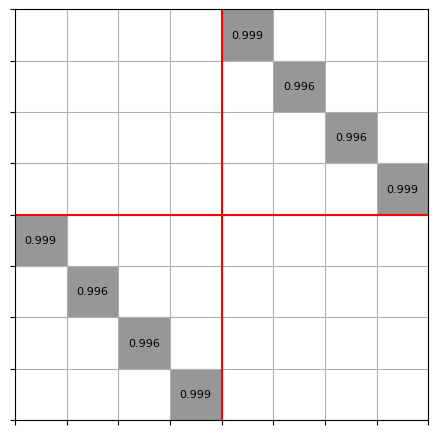GDS Taper#
Create a Taper and Simulate
import meow as mw
import gdsfactory as gf # pip install meow-sim[gds]
from gdsfactory.cross_section import cross_section
import matplotlib.pyplot as plt
import numpy as np
Example Taper#
Note:
meowexpects the propagation direction to be thez-axis! This makes thezx-plane parallel with the chip and they-axis perpendicular to the chip. Somewhat confusingly, the (x, y) GDS coordinate tuple hence maps onto the (z, x)meowcoordinate tuple. Whereas the y coordinate from meow denotes the direction perpendicular to the chip. (I will probably change themeowconvention in the future.)
def example_gds_cross_section(
width: float = 0.450,
clad_width: float = 2.0,
) -> gf.CrossSection:
"""a strip waveguide cross section
Args:
width: the width of the strip waveguide
clad_width: the width of the cladding
"""
core_width = width
port_names = ("in0", "out0")
sections = (
gf.Section(width=core_width, offset=0, layer=(1, 0), name="core"),
gf.Section(
width=clad_width,
offset=0.5 * (core_width + clad_width),
layer=(2, 0),
name="upper",
),
gf.Section(
width=clad_width,
offset=-0.5 * (core_width + clad_width),
layer=(2, 0),
name="lower",
),
)
cs = cross_section(
width=width,
port_names=port_names,
sections=sections,
)
return cs
@gf.cell
def example_taper(
width_input: float = 0.450,
width_output: float = 1.0,
length: float = 10.0,
) -> gf.Component:
"""create a linear taper
Args:
width_input: input width of the linear taper
width_output: output width of the linear taper
length: the length of the linear taper
"""
input_cs = example_gds_cross_section(width_input)
output_cs = example_gds_cross_section(width_output)
transition = gf.path.transition(input_cs, output_cs, width_type="linear")
length = gf.snap.snap_to_grid(length) # type: ignore
path = gf.path.straight(length)
component = gf.path.extrude_transition(p=path, transition=transition)
return component
taper = example_taper(width_input=0.45, width_output=1.0, length=20)
taper

Example Structure Map#
def example_extrusions(
t_slab: float = 0.020,
t_soi: float = 0.220,
t_ox: float = 1.0,
):
"""create some simple extrusion rules
Args:
t_slab: the slab thickness
t_soi: the SOI thickness
t_ox: the oxide layer thickness
"""
extrusions = {
(1, 0): [
mw.GdsExtrusionRule(
material=mw.silicon,
h_min=0.0,
h_max=0.0 + t_soi,
mesh_order=1,
),
mw.GdsExtrusionRule(
material=mw.silicon_oxide,
h_min=-1.0,
h_max=t_soi + t_ox,
buffer=t_ox / 2,
mesh_order=2,
),
],
(2, 0): [
mw.GdsExtrusionRule(
material=mw.silicon,
h_min=0.0,
h_max=0.0 + t_slab,
mesh_order=1,
),
mw.GdsExtrusionRule(
material=mw.silicon_oxide,
h_min=-1.0,
h_max=t_slab + t_ox,
mesh_order=2,
),
],
}
return extrusions
Extrude GDS#
extrusion_rules = example_extrusions()
structs = mw.extrude_gds(taper, extrusion_rules)
mw.visualize(structs, scale=(1, 1, 0.2))
Divide into Cells#
w_sim = 1.0
h_sim = 1.0
mesh = 100
num_cells = 10
dbu = taper.layout().dbu
taper_length = abs(taper.bbox().right - taper.bbox().left) * dbu
Ls = [taper_length / num_cells for _ in range(num_cells)]
cells = mw.create_cells(
structures=structs,
mesh=mw.Mesh2D(
x=np.linspace(-0.75, 0.75, mesh + 1),
y=np.linspace(-0.3, 0.5, mesh + 1),
),
Ls=Ls,
)
mw.visualize(cells[0], cbar=False)
plt.show()
mw.visualize(cells[-1], cbar=False)
plt.show()
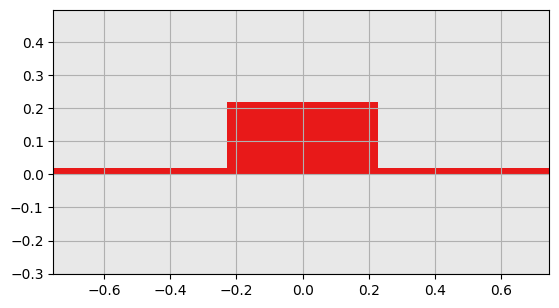

Find Cross Sections#
env = mw.Environment(wl=1.55, T=25.0)
css = [mw.CrossSection.from_cell(cell=cell, env=env) for cell in cells]
mw.visualize(css[0])
mw.visualize(css[-1])
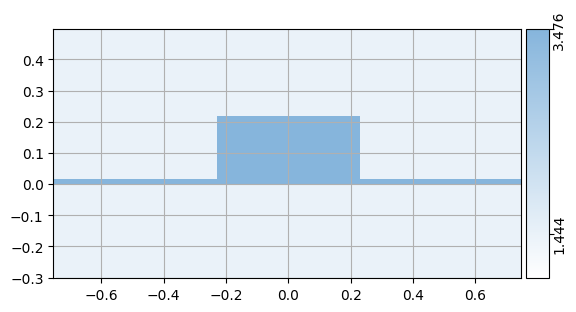

num_modes = 4
modes = mw.compute_modes(css[0], num_modes=num_modes)
mw.visualize(modes[0])
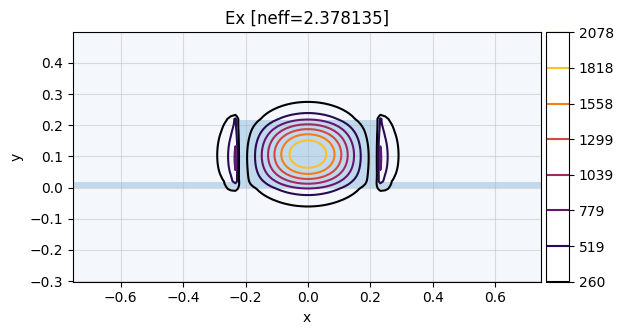
Compute Modes (FDE)#
%%time
num_modes = 4
modes = [mw.compute_modes(cs, num_modes=num_modes) for cs in css]
CPU times: user 15.6 s, sys: 162 ms, total: 15.8 s
Wall time: 12.3 s
mw.visualize(modes[0][0], fields=["Hx"])
mw.visualize(modes[-1][1], fields=["Hx"])

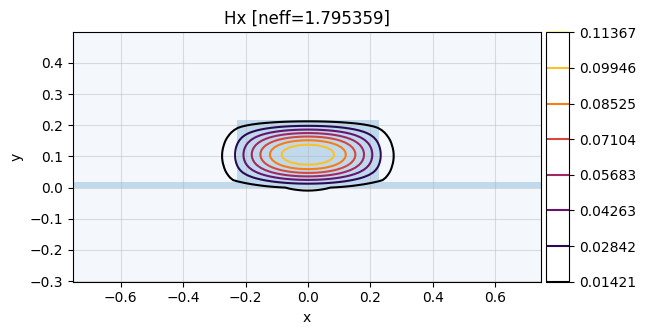
Calculate S-matrix (EME)#
S, port_map = mw.compute_s_matrix(modes, cells)
print(port_map)
mw.visualize((abs(S), port_map))
{'left@0': 0, 'left@1': 1, 'left@2': 2, 'left@3': 3, 'right@0': 4, 'right@1': 5, 'right@2': 6, 'right@3': 7}
